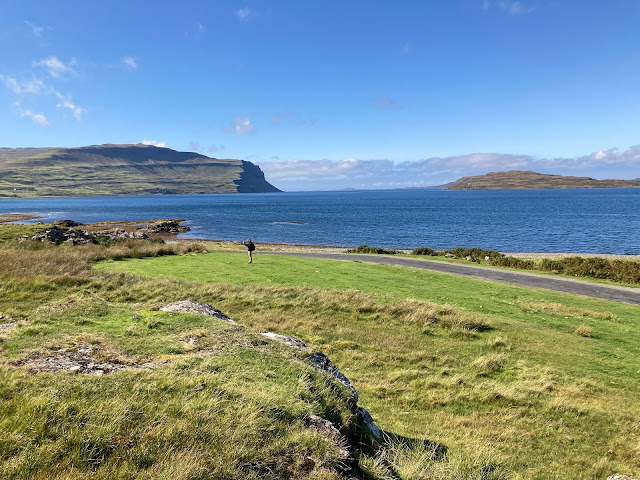Utterly Dark and the Tides of Time is published today, and I’m on my way to the Islay Book Festival, where it all began, back in 2019. Spending time on the island then reminded me that I’d been toying with the idea of writing something about an imaginary archipelago since at least my first year of art college, and I went home feeling it was probably time I got started. Utterly Dark and the Face of the Deep was the result.
But on the way to Islay this time, Sarah Reeve and I have stopped off on Mull, which is the place where it really all began. Because the reason I’d been toying with imaginary archipelagos for so long must have had something to do with an earlier visit to the Hebrides, back in 1977, when my parents, my sister and I camped on the shores of Loch na Keal. This is how it looked then:
And this is how it looks now:
We had a lot of holidays like this, to Cornwall, Wales, the Lake District, and similar places - my parents had a thing for mountains and beaches, the more remote the better. There wasn’t a lot for little me to do there except read, and when I ran out of books I started making up my own: it was very good training for a writer.
This time, Sarah and I also took a trip to Staffa, which I remember doing with my family on that previous visit, although I’d forgotten just how weird and powerful a place it is. The legends of the Atlantic seaboard are full of strange voyages to magical islands, and of course those are in Utterly Dark’s DNA too. I think one of the islands St Brendan visited was supposed to rise up out of the sea on huge pillars, and looking at Staffa with its fringe of basalt columns made me wonder if that was what inspired it. Meanwhile, off in the west, heat-haze was doing strange things to the long, low Treshnish Isles, making them look very much like the Hidden Lands in the Utterly Dark books.
The Hidden Lands had a bit of a rest in the second Utterly story Heart of the Wild, which turns inland and finds magic in the woods. But in the new book they feature strongly again. There are a lot of characters to deal with now, because the friends Utterly made in the original book all deserve adventures of their own. Tides of Time sends them off on separate but interconnected quests. It is 1812 now. Utterly returns to the sea, honouring the promise she made to her mother, the ancient and all-powerful Gorm. Meanwhile, Will is roped into an official expedition to the Hidden Lands, and Aish goes wandering in the Hunter’s forests. And in the course of their adventures, Utterly and her friend Egg end up in the strangest place they’ve yet visited: the 1970s.
For it turns out the Gorm’s magic extends through time as well as space, and once Utterly gets mixed up in it she finds herself washed up in a new century, where human science has grown at least as powerful as the Gorm. She finds herself washed further too - I’ve not written a story involving time travel before, so I wasn’t going to pass up the opportunity of paying brief visits to the beginning and end of the world. But the main part of her and Egg’s adventures take place on the Wildsea of 1971 - an age of wonders to children from the early Nineteenth Century. I suppose the obvious thing would have been to bring them to our own time (which is an age of wonders even to a boy from the 1970s). But Utterly’s adventures so far have been historical novels, and I didn’t want to introduce stuff from the present day. So the 19th Century clutter that helped to anchor the previous books in their period has been joined by a new layer of clutter - Penguin biscuits, T-shirts, Nessie, the Beatles and Bob Dylan. I’ve even managed to fit in a reference to a sign that used to stand outside a shop in Pevensey: ‘Lost Your Car Keys On The Beach? Get Some Here, 50p Each’ We’d see it each summer when we went camping at Norman’s Bay, and each the price had increased - an early lesson in the effects of inflation.
To young readers, of course, there probably isn’t much difference between 1971 and 1812 - it’s all just the olden days to them. But it’s somehow easier to imagine magic happening in the past. I hope they’ll enjoy exploring Wildsea in all its different eras with Utterly and Egg as their guides. I know I did.
My events in the Islay Book Festival can be found here. Please come along if you can!
And there will be an online launch event for Utterly Dark and the Tides of Time on the 21st September, when I’ll be in conversation with Nikki Gamble, who is always an excellent host. The event is free, but you’ll need to reserve a place, which you can do here.
The covers and internal illustrations for the Utterly Dark books are all by Paddy Donnelly.






Comments